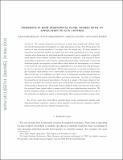Inference in High-Dimensional Panel Models With an Application to Gun Control
Author(s)
Belloni, Alexandre; Hansen, Christian; Kozbur, Damian; Chernozhukov, Victor V
Download1411.6507.pdf (563.8Kb)
OPEN_ACCESS_POLICY
Open Access Policy
Creative Commons Attribution-Noncommercial-Share Alike
Terms of use
Metadata
Show full item recordAbstract
We consider estimation and inference in panel data models with additive unobserved individual specific heterogeneity in a high-dimensional setting. The setting allows the number of time-varying regressors to be larger than the sample size. To make informative estimation and inference feasible, we require that the overall contribution of the time-varying variables after eliminating the individual specific heterogeneity can be captured by a relatively small number of the available variables whose identities are unknown. This restriction allows the problem of estimation to proceed as a variable selection problem. Importantly, we treat the individual specific heterogeneity as fixed effects which allows this heterogeneity to be related to the observed time-varying variables in an unspecified way and allows that this heterogeneity may differ for all individuals. Within this framework, we provide procedures that give uniformly valid inference over a fixed subset of parameters in the canonical linear fixed effects model and over coefficients on a fixed vector of endogenous variables in panel data instrumental variable models with fixed effects and many instruments. We present simulation results in support of the theoretical developments and illustrate the use of the methods in an application aimed at estimating the effect of gun prevalence on crime rates.
Date issued
2015-11Department
Massachusetts Institute of Technology. Department of EconomicsJournal
Journal of Business & Economic Statistics
Publisher
Informa UK Limited
Citation
Belloni, Alexandre, Victor Chernozhukov, Christian Hansen, and Damian Kozbur. “Inference in High-Dimensional Panel Models With an Application to Gun Control.” Journal of Business & Economic Statistics 34, no. 4 (September 15, 2016): 590–605.
Version: Original manuscript
ISSN
0735-0015
1537-2707